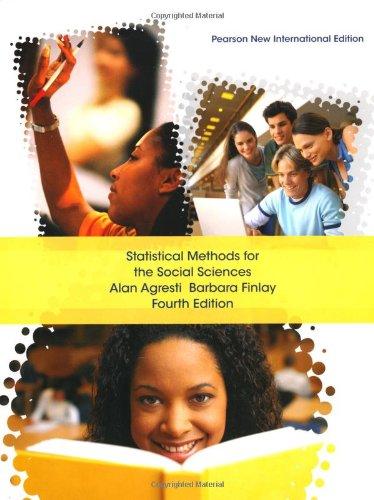11.15. The GSS has asked subjects to rate various groups using the feeling thermometer. The rating is
Question:
11.15. The GSS has asked subjects to rate various groups using the "feeling thermometer." The rating is between 0 and 100, more favorable as the score gets closer to 100 and less favorable as the score gets closer to 0. For a small data set from the GSS. Table 11.16 shows results of fitting the multiple regression model with feelings toward liberals as the response, using explanatory variables TABLE 11.16 Variable Coefficient Intercept 135.31 Ideology -14.07
(3.16)**
Religion -2.95
(2.26)
F 13.93**
R 2
0.799 Adj. R 2
0.742 in) (10)
political ideology (scores 1 = extremely liberal, 2 = liberal, 3 = slightly liberal, 4 = moderate, 5 = slightly conservative, 6 = conservative, 7 =
extremely conservative) and religious attendance, using scores (1 = never, 2 = less than once a year, 3 = once or twice a year. 4 = several times a year, 5 = about once a month, 6 = 2-3 times a month, 7 = nearly every week, 8 = every week, 9 = several times a week). Standard errors are shown in parentheses.
(a) Report the prediction equation and interpret the ideology partial effect.
(b) Report the predicted value and residual for the first observation, for which ideology = 7, religion = 9. and feelings = 10.
(c) Report, and explain how to interpret, R 2
.
(d) Tables ofthisform often put * by an effect having P < 0.05, ** by an effect having P < 0.01, and *** by an effect having P < 0.001. Show how this was determined for the ideology effect, and discuss the disadvantage of summarizing in this manner.
(e) Explain how the F-valuc can be obtained from the /?2
-value reported. Report its df values, and explain how to interpret its result.
(f) The estimated standardized regression coefficients are —0.79 for ideology and —0.23 for religion. Interpret.
Step by Step Answer:

Statistical Methods For The Social Sciences
ISBN: 9781292021669
4th Edition
Authors: Barbara Finlay, Alan Agresti






